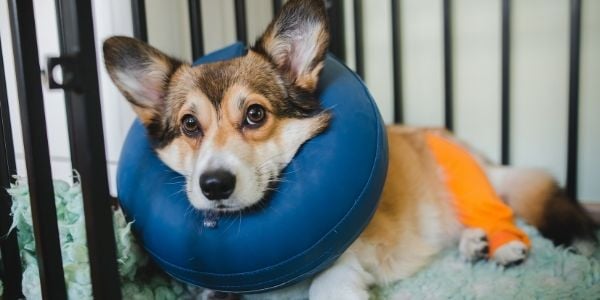 It can be stressful anytime a loved one is having a surgical procedure, and that isn’t limited to just humans!
It can be stressful anytime a loved one is having a surgical procedure, and that isn’t limited to just humans!
When our dogs have surgery, it can be a very emotional and trying time!
Often, we think the stressful part is over once they are out of surgery and back home.
But, there's a lot of care, observation, and planning required to look after a patient who is recovering, especially one who can’t speak our language!
We are going to outline what you need to know to care for your dog post-surgery to ensure you can provide the best care possible and that they are able to recover as fast as the doctor ordered!
Skip to section:
How to Prepare for Your Dog's Recovery
Depending on what kind of surgery your dog had, life may not return to normal for several weeks to months! It is important to ensure you are prepared before they arrive back home so that it’s not a last-minute dash to get everything ready – eliminating as much anxiety for you as possible.
Ask your veterinarian about all of the things outlined below so you're as prepared as possible for your pup's recovery.
Set Up a Recovery Space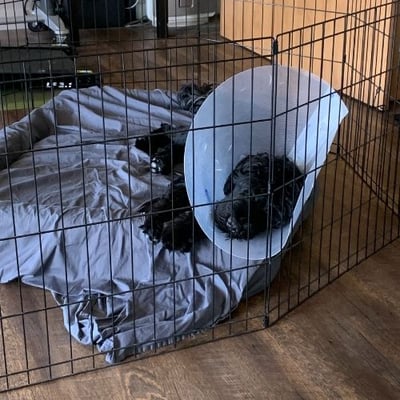
A recovery space may include their crate or a small, enclosed playpen area to limit the amount of movement and activity your dog can do while recovering. A small dog-proofed room, such as a bathroom with a gate in the doorway, may also work.
Make sure to block the tub so they don't climb or jump in, lock any cabinets and drawers, and put the toilet seat down!
Ensure they have soft, comfortable bedding that is easy for them to get on and off without too much difficulty.
Move their food and water bowls to their recovery space so they always have access to fresh water, and they don’t have to go far to get to it.
You may want to elevate their bowls a little to assist with eating and drinking, as wearing a cone often means they need more "clearance."
Setting up your dog's recovery space before bringing them home will help you recognize if you have forgotten anything, giving you the chance to run out and grab any supplies.
Ex-pens like the one in the photo above easily hook up to wire crates, helping make a larger yet still confined space. A pen area is often the best choice for dogs who are not crate trained prior to their surgery.
Some dogs find confinement of any kind stressful, so it’s ideal to introduce them to hanging out in their pen prior to their procedure.
If you haven't already crate trained your dog prior to their surgery, you'll need to spend several weeks preparing them for this experience so they won’t be stressed. Read our article on how to crate train your dog.
If you need to buy a crate, see here for tips on how to properly measure its size.
*Additional advice: You may wish to invest in a pet camera to be able to monitor your dog when you aren’t at home. There are several dog monitoring cameras available to help you keep an eye on their movement or if they are in distress at any time.
Where to Set Up the Recovery Space
With most surgeries, unless they are in or around the mouth or face, your post-operative instructions are going to likely recommend that your dog doesn’t climb up and down stairs for at least a few weeks.
If you have stairs in your house or apartment, make sure that your dog’s recovery space is set up somewhere they won’t have to climb to get to. Ensure the stairs are blocked off so that your dog doesn’t try to climb them when you’re not home or unable to monitor your dog, for example, if you’re upstairs asleep.
Avoid putting their recovery area near direct sunlight. Under no circumstances should you place their crate by a fireplace or on top of or close to heating or cooling vents (i.e., radiators or baseboard heating units).
Avoid drafty areas, such as by doors that lead outside or by uninsulated windows. Also, make sure their crate or recovery space isn’t set up in or near any loud noises (such as a washing machine or dryer) and is in a low-traffic area of your home so that you don’t continually disturb your pup while they’re recovering.
Additionally, for safety, avoid setting up their crate or space near electrical outlets or cords, houseplants that could be toxic, or other items that could easily be chewed if your dog gets bored.
Read more on how to set up your dog's crate for comfort and safety.
Plan Your Dog's Potty Access
Bathroom trips take on a whole new meaning post-surgery. Not only do you both have to learn how to walk with an Elizabethan collar (the all-important but dreaded cone of shame!), but you also need to limit certain movements and learn new ways to navigate in order not to harm the surgical area.
Determine which route is the easiest and shortest way to get outside. You want to avoid slippery floors, stairs, and any other obstacles as much as possible.
For slippery floors, you can lay down yoga mats or non-slip rugs so your dog won’t slip.
If you can’t avoid stairs, there are a couple of options. Depending on the size of your dog and the type of surgery, carrying them up and down the stairs can sometimes be the easiest thing. Depending on how many steps, you can put up a secure, non-slip ramp so your dog can easily walk up and down. But use caution that they don’t attempt to leap off the ramp, especially as they are feeling better.
If your dog has had surgery on their back legs, you can use a sling to help them up and down the stairs. There are also front-leg and full-body slings.
Here are a few harness and sling choices that would work for dog surgery patients:
Sling for Back-end Support (easy on/off)
DIY sling: Use a VERY strong reusable shopping bag as a sling. This video demonstrates how to make and use one.
Walking your dog with a short leash and harness is essential for control. Remember, you don’t want your dog to run, jump, or leap around. A short leash also helps if you need to assist your dog in holding up the cone while walking. One hand holds the leash while you grab the lip of the cone with the other hand. Many dogs find this helpful for the first couple of days until they get the hang of it.
Note: It may take a few tries for your dog to figure out how to walk with their cone on. DO NOT be tempted to remove it. Many pet owners have done this, only to not be able to get it back on or not put it on securely. Either scenario increases the likelihood that your dog will harm their surgical site.
If your dog absolutely refuses to walk with the cone on, contact your veterinarian for possible alternatives. We have many cone alternative suggestions based on the type of surgery your dog has had.
In cases where there are several flights of stairs between your dog and the outdoors, consider making an indoor potty area. You can give them a potty pad if they are trained to use these, so again, they don’t have to walk far to relieve themselves. Using a Fresh Patch is a perfect way to use real grass – mimicking the outdoors – in your home or on a nearby deck or patio.
Supplies for Post-Surgery
Other than the supplies for a comfortable confinement and recovery area, you may need things to help your at-home patient recover.
Medication enticers: Pill pockets or pill wraps work well, but so does a little bit of cheese, peanut butter (xylitol-free), applesauce, or marshmallows (for dogs with food allergies, there are vegan marshmallows).
Cone or an alternative: It's imperative that your dog wear protection to keep them from licking, scratching, or biting at their incision. If you're looking for a cone alternative, we have some options, but check with your veterinarian, as they'll know the best option for the type of surgery your dog had.
Medical boot: If your veterinarian recommends a medical boot to protect your dog's paw or lower leg, this Medipaw protective boot is a good option.
Bland diet: If your veterinarian requires your dog to eat softer food or a bland diet, you'll want to make sure to have some on hand. Read more about our suggestions for homemade recipes and store-bought solutions. But make sure to take the advice of your vet first, since they know your dog best.
Calming Aids: Your dog is experiencing something totally new and is understandably stressed and anxious. Consider using calming pheromone diffusers as well as playing calming music in their recovery space. In addition to this, you can also give them calming treats, such as VetriScience Calm & Confident Chews or Nutramax Solliquin. To prevent anxiety over being confined and the lack of activity, consider providing your dog with mental enrichment, such as food puzzles or snuffle mats.
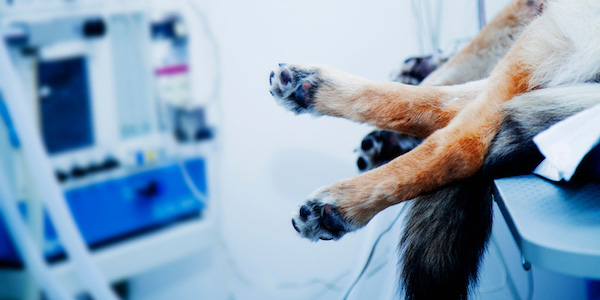
What to Do and Expect After Your Dog's Surgery
What to do and expect will vary greatly with the type of surgery your dog will be having. So, even if your dog has had surgery in the past, this experience may require an entirely different level of care.
Knowing what to do after your dog comes home will help you prepare and feel less overwhelmed.
Before your dog’s surgery, discuss with your veterinarian what your dog’s recovery will involve and the extent of care that will be required. Be sure to ask them any questions you may have. Some important things to ask include:
- Can my dog be left alone (but confined) until I return from work, or do I need a caregiver to come during the day?
- If I can’t take time off from work, can I dayboard my dog at the hospital to aid in their recovery? If yes, how much will this cost?
- How do I medicate my dog, and how often?
- If medications are required multiple times per day, is there a way to schedule them around my away-from-home hours?
- How can I safely confine my dog when they don’t like crates?
- How do I restrict my dog’s activity?
- How much activity is ok?
- Can I have my other pets around my dog, who just had surgery? If not, how do I separate them, and for how long?
- And whatever else you may think of that can have an impact on your dog’s recovery.
Skip to section:
The Veterinarian's Discharge Notes
Every dog that undergoes a surgical procedure, from a routine spay or neuter to an enucleation (eye removal), fracture repair, or even dental extraction, will most likely receive written or emailed discharge instructions from their veterinarian.
These instructions typically include standard information about the procedure performed and how your dog did under anesthesia.
They will also include pertinent information such as expectations post-operatively, including:
-
information on how soon your dog can be fed that day
-
whether they can eat hard food and when
-
how long they must wear a cone (IF they have to wear one)
-
what activity level they should follow, like IF they are allowed to go on walks, how long those walks can be, and IF they can go up and down stairs, allowed to swim, or be bathed
-
whether they can go to doggy daycare, etc.
Not only will these instructions hold a LOT of information for you, but they will stop you from panicking once you are home alone with your new patient.
Make sure to read the instructions at least twice, as it's really easy to miss something, and if you have any questions after you get home, DON'T hesitate to contact your vet. They are more than willing to answer your questions related to the surgery and your dog's recovery. They know the procedure they performed, as well as any health conditions if your dog has any.
Anesthesia Recovery
Because of the anesthesia your dog received, it is likely they will still be mildly sedate (groggy) when you pick them up – if you are bringing them home the same day of their surgery. Your dog won't be able to walk home or jump into the car as if everything is ‘normal,’ so you'll need to plan accordingly (e.g., use a ramp or a sling).
Your pup will likely be moving slowly and gingerly, so try not to rush them. Furthermore, because of the anesthesia, they will likely want to rest for the remainder of that afternoon or evening (and sometimes the next day), which is normal.
When you get home, place your dog in their new recovery space. Make sure they know where their food, water, and pee pad (if necessary) are. Make sure they are comfortable on their bed – can get on and off without help – and can access their food and water with ease.
Activity Reduction
All dogs after surgery are going to require a period of activity reduction. Generally, a dog should not be allowed to run, jump on and off any furniture, go up and down stairs, or play with other animals during their recovery time, which can be as short as 14 days or as long as 4 months.
Restricted activity typically means that your dog should only be taken out for short, controlled leash walks to relieve themselves 3 to 4 times a day, or as much as they need. To help balance out the reduction in physical exercise, increase your dog's mental enrichment with interactive feeders and puzzles to provide an outlet for energy and encourage calm.
The level of activity restriction will vary slightly depending on the specific procedure they underwent (see specifics below for common surgery types).
For certain surgeries, like surgery to the eyes, neck, or back leg, a harness is better to use than a collar for walks. Ask your veterinarian if this applies to your dog.
Care should also be taken to ensure your dog avoids slippery floors and stairs. Being in pain and wearing a bandage will make it difficult to move and navigate.
Allowing your dog to be active too soon can:
- Delay healing
- Cause swelling and pain at the surgical site
- Increase the risk of the incision opening (dehiscing)
- Cause a fluid pocket (seroma) to develop, which may require drainage
- Cause the internal sutures to loosen and not heal
- Cause poor healing of bone
- Cause any surgical implants to shift, resulting in the procedure failing
Soft-tissue surgeries (e.g., spay/neuter, cystotomy, splenectomy)
Typically, a dog will have their activity restricted for 2 weeks. This is due to the amount of time the body needs to recover and for the incision to be completely healed.
Orthopedic surgeries (e.g., bone breaks)
For these types of surgeries, the activity restriction is much longer. Usually, from 6 to 12 weeks, depending on the procedure. This is because bone takes a longer time to heal than soft tissues such as muscle and skin.
See more detail below for some of the more common surgery types.
Cone Usage: Prevent Access to Their Wounds
Post-surgery, if recommended by your vet, your dog should be wearing a cone (otherwise known as an e-collar*) at ALL times.
*Dog cones are sometimes called e-collars, which is the short form for Elizabethan collar – not to be confused with an electronic shock collar. They got this name because of their likeness to ruffs popularized by Queen Elizabeth I in the Tudor period. It's a wonder why these labels stick!

The cone serves a very important purpose. It prevents dogs from chewing or licking at any incisions or sutures (stitches) within reach of their mouth.
A dog’s mouth harbors a lot of bacteria, and their tongue is similar to sandpaper. So, when a dog chews or licks at an incision, they are not only causing a lot of trauma from their tongue but may also be introducing bacteria to the incision site, which may result in an infection.
Typically, a cone is required anywhere from 10 to 14 days for routine soft-tissue procedures and 6 to 12 weeks for orthopedic procedures. This amount of time will allow the area to heal adequately so that if your dog does decide to chew or lick at the surgical site, there will be much less chance of them causing an infection or opening the site up and causing serious problems.
We veterinarians are not recommending this "cone of shame" to cause you and your dog additional hassle. We have seen the outcomes of what ‘good dogs’ do when their owners take their eyes off of them for ‘just one minute,’ including evisceration (where their intestines come out of the incision of an abdominal surgical site, for example, after a spay) and no, this is not fun for anyone.
So please believe us when we say they are necessary. In the end, it can spare your dog a lot of pain and suffering and can save you a lot of money in the end, as well.
It's also best to prepare your dog for wearing their cone well in advance of their surgery. Cathy Madson, Preventive Vet's certified dog trainer, provides some simple training steps in the video below to help your dog love or at least tolerate wearing their cone.
Make sure the cone is long enough: It needs to reach past your dog's nose. It should be at least one inch longer than their nose when the cone is pushed as far back down their neck as possible.
Make Sure the Cone Fits
Although your veterinary team will ensure that the cone they provide your dog with is the most appropriate size, owners like to either:
- Purchase their own cone that may be more comfortable, softer, or cuter
- Adjust the sizing because they feel it is too tight and they ‘feel bad’ for their dog or guilty that they have to wear one.
It is imperative that the size is appropriate for your dog. If your dog can get their cone off when you aren’t paying attention, like when you're asleep, they will get at their surgical site and wreak havoc. It only takes a few millimeters (less than 1/2 an inch) to alter a dog's ability to get a cone over their head, and you’ll be back at the veterinary hospital with a pet that is potentially in worse shape than before.
Mary Berry's cone in the photo above was ordered online in anticipation for her spay. It's clearly the wrong size. Luckily her people where planning ahead and got a larger one in time for the desensitizing her to the cone prior to her surgery.
Ensure the cone is long enough that it reaches past your dog's snout. It should be at least one inch longer than their nose when the cone is pushed as far back down their neck as possible. This way, you can be satisfied that your dog won’t be able to get at any wound, especially if the surgical site is on a paw that they are easily able to reach when they bend or twist.
Dogs typically don’t like things such as bandages on their bodies and will, given the chance, likely chew them off. So, if the cone isn't being used or it's ineffective, now you have a dog that has ingested something foreign that could cause obstruction – which is a whole issue in and of itself. Please use the cone that your veterinarian recommends, even if you feel bad for your dog.

Alternatives to Using a Cone
Some dogs don't mind the hard plastic cone that is typically provided by the veterinarian after surgery. There are so many more choices now than there have ever been, and I've used many alternatives for my patients, from blow-up collars to surgical suits (like in the photo above). Many of these options are great, but you have to take stock of a few things before you throw the cone in the trash. Check out our cone recommendations and considerations here.
A warning about DIY homemade cone alternatives: Under no circumstance is it recommended that you attempt to cobble together a cone, lick sleeve, surgical suit, etc., at home. This is for many reasons, with the number one being you could cause your dog far greater harm than any benefit. At-home cones or alternatives that are too tight can cause neck wounds, injuries, or constrict airways or blood vessels.
Medications
Most surgical patients will be sent home with one or more medications to help with pain, inflammation, or antibiotics to prevent or treat an infection.
Make sure you put all medications, particularly those that require refrigeration, away as soon as possible. Ensure all medications are out of reach of your dog so they can't get into them and potentially overdose. Some of their medications are flavored which makes them even more enticing and tasty to your dog. Dogs are scavengers, and toxicity happens often – that's why veterinary products is number 7 on the top 10 ASPCA pet poison list.
If your dog requires any doses of medication that day or night, make sure you do so when and as directed, particularly if it is a pain medication or a sedative, as this will aid in their healing process.
It is crucial that you give your dog their medications exactly as directed by your veterinarian, no matter if your dog seems to be doing okay or if they don’t "appear to need the medications."
Unfortunately, you can’t ask your dog how much pain they are in, so it is best to err on the side of caution and prevent discomfort, then assume they aren’t painful and allow them to be in pain all day. Dogs are masters at hiding pain and pushing themselves beyond their limits.
Check with your veterinarian if the medications should be given with food and, if so, a full meal or just a snack.
If you ‘dry pill’ your dog, be sure to give them water afterward since some medications can cause esophageal strictures if they get ‘stuck’ on the way down. Check out our tips if you need help giving your dog a pill.
Incision Care
Monitoring your dog’s incision is very important to ensure that no complications arise. Seeing the incision may not always be possible if there is a bandage in place. However, typically, bandages are changed frequently by your veterinarian, and they will be able to monitor the incision. Nonetheless, see below for what you should be looking for if your dog has a bandage in place.
Monitor your dog’s incision at least twice daily during their recovery period. These are the things to monitor for:
- Bleeding: A few drops of dried blood are typical after surgery. However, if there is continuous bleeding from the incision, this is not normal, and you should seek veterinary care ASAP.
- Swelling or Redness: Slight swelling and minor redness or bruising are typical after surgery, and it may get worse the first few days after surgery. After a few days, it should gradually improve. If the swelling, redness, or bruising gets worse, contact your veterinarian ASAP.
- Discharge: If you notice any abnormal or discolored discharge coming from the incision site, seek veterinary care ASAP.
- Dehiscence: This is when the edges of the incision begin to separate. If you notice the incision beginning to open up, contact your veterinarian ASAP.
- Pain: Minor discomfort is normal after surgery. However, you should be able to gently touch the area around the incision without a reaction. If your dog seems painful, they may not be getting enough pain medication, or this could be a sign of infection if there is also excessive swelling, redness, or discharge present. If your dog seems more painful than they should, contact your veterinarian.
Bandage Care
A cone should be worn at ALL times on ANY pet with a bandage or splint to prevent them from chewing, causing damage to, moving it, or introducing bacteria from their mouth.
If your dog must wear a bandage, it is important that you check the bandage at least twice daily for many reasons. A bandage can be harmful and not beneficial if you don’t follow the directions below:
- Change the bandage once a week. A bandage should be changed at least once per week unless otherwise advised by your veterinarian. Typically, this is done by your veterinarian. However, in some cases, your veterinarian may train you on how to do a proper bandage change at home (if you are comfortable with it).
- Keep all splints and bandages clean and dry. Should the bandage become wet or soiled, the bandage should be changed immediately. A wet bandage is dangerous as this will cause the skin and fur under the bandage to become damp, introduce infection, and cause major irritation and inflammation.
- Protect the bandage when going outside. When taking your dog outside, a waterproof protective covering should be placed over the splint or bandage to ensure that it does not get wet. This protective covering over the bandage should be removed when indoors.
- Make sure the bandage has not become too tight. You can do this by monitoring your dog’s toes for swelling, which may be protruding from the bandage if the bandage is on their paw. If the toes "V" away from one another as if going in opposite directions, that may indicate swelling, especially if the toes look larger in size than the toes on the other paws and/or if they are redder in color than other toes. Loosen the bandage promptly in this case, and bring your dog to a veterinarian right away.
- Make sure the bandage has not become too loose. A loose bandage or splint is also dangerous as it is not performing the duties it is supposed to. If it has slipped, it can chafe, causing pain and irritation, and may start to act as a pendulum — damaging bones or resulting in further damage to broken bones.
- Monitor for slipping, twisting, or a smell. If the bandage should slip, twist, develop a foul odor, or otherwise become damaged, your dog should have their bandage changed immediately!
- Monitor for comfort. If the bandage appears to be causing severe discomfort, or your dog was using the limb well but then stops using it, please have them seen ASAP for an exam and bandage change.
A warning about DIY homemade bandage alternatives: Under no circumstance is it recommended that you attempt to make a homemade bandage. I have personally seen many dogs suffer from serious wounds from self-applied "at home" bandages by owners with good intentions. Using things like elastic bands or hair ties is an absolute NO-NO. They lead to amputation of ears, paws, and toes, you name it. I’ve had to amputate because of a hair tie and elastic band being placed on a dog – it's tragic!
What to Do When You Bring Your Dog Home from Surgery
Skip to:
Caring for Your Female Dog After Spay Surgery
When a dog is spayed, the surgery performed is typically an ovariohysterectomy (OVH), where the dog’s uterus and both ovaries are removed so that they can't reproduce or have any further ‘heat’ cycles.
Although this is one of the most common, routine surgeries performed day to day in a veterinary hospital, many owners don’t recognize that this is major abdominal surgery. The uterus is located within the abdomen, right next to the intestines, stomach, liver, and kidneys. And all these organs are navigated around and through during a spay surgery.
Because a spay surgery is a substantial surgery, it shouldn’t be treated in a trivial manner, even if your dog seems to be acting ‘fine’ afterward.
Activity reduction
Typically, it is recommended a dog is strictly rested for 14 days after a routine spay surgery due to the nature of the surgery (i.e., major abdominal surgery). No jumping, rough play, long walks, up and down stairs, or jumping on and off furniture. Ideally, rested inside a crate, particularly when not monitored.
Incision care
After a routine spay procedure, a dog may or may not have skin sutures (stitches), depending on your veterinarian's choice. Some veterinarians prefer to use internal skin sutures; however, this does NOT mean that your dog doesn’t need to wear a cone or have their incision monitored just as closely. The only difference is that your dog doesn’t need stitches removed in 10–14 days, as they will dissolve on their own.
Bandage care
No bandages are needed.
Medication
Typically, non-steroidal anti-inflammatory pain medication and analgesic pain medication. Possibly sedatives and/or antibiotics.
How long should your dog wear a cone?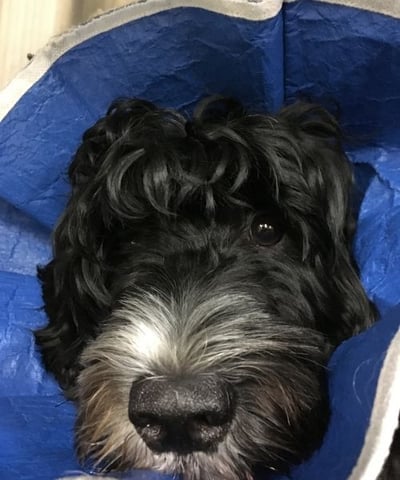
Your dog will need to wear their cone for 10 to 14 days after surgery. The reason for this length of time is that it takes about 10 to 14 days for your dog’s incision to heal as well as handle stretching and tension.
Is a cone alternative allowed? If appropriate for your dog, you can try an alternative collar option or start with a traditional cone and then transition to a spay suit (be sure to check with your veterinarian first). See some cone alternative options here.
Caring for Your Male Dog After Neuter Surgery
When a dog is neutered, both testicles are removed so that they are no longer able to reproduce.
This is one of the most common, routine surgeries performed day to day in a veterinary hospital. Conversely, unlike a spay surgery, this is not considered a major abdominal surgery as the testicles are located on the outside of the body, unlike the ovaries.
However, this is still a significant procedure requiring general anesthesia and requires specific post-surgery care for appropriate healing.
Activity reduction
Typically, it is recommended a dog is strictly rested for 7–12 days after routine neuter surgery. No jumping, rough play, long walks, up or down stairs, or jumping on and off furniture. Ideally, rested inside a crate, particularly when not monitored.
Incision care
After a routine neuter procedure, a dog may or may not have skin sutures (stitches), depending on your veterinarian's choice. Some veterinarians prefer to use internal skin sutures; however, this does NOT mean that your dog doesn’t need to wear a cone or their incision monitored just as closely. The only difference is that your dog doesn’t need stitches removed in 10–14 days, as they will dissolve on their own.
Bandage care
No bandages are needed.
Medication
Typically, non-steroidal anti-inflammatory pain medication and analgesic pain medication. Possibly sedatives and/or antibiotics.
How long should your dog wear a cone?
For 10 to 14 days.
Is a cone alternative allowed? If appropriate for your dog, you can try an alternative collar option or use a cone and then attempt to transition to a neuter suit (be sure to check with your veterinarian first). See some cone alternative options here.
Caring for Your Dog After Mass Removal Surgery
Mass removal surgeries can differ greatly depending on the size of the mass, the location, as well as the number of masses being removed.
Activity reduction
Typically, it is recommended a dog is strictly rested for 14 days after most mass removal surgeries that require anesthesia and have sutures. No jumping, rough play, long walks, up and down stairs, or jumping on and off furniture. Ideally, rested inside a crate, particularly when not monitored.
Incision care
As with most soft-tissue surgery, your dog may or may not have skin sutures (stitches) depending on your veterinarian's choice.
Bandage care
Typically, none, but it is dependent on location.
Medication
Typically, non-steroidal anti-inflammatory pain medication and analgesic pain medication. Possibly sedatives and/or antibiotics.
How long should your dog wear a cone?
For 10 to 14 days.
Is a cone alternative allowed? A surgical suit or dog t-shirt may be appropriate, depending on the location of the mass that was removed. If the mass was on a leg, a leg sleeve may be appropriate. If appropriate for your dog, you can try an alternative collar option. This may not be feasible for masses removed on the lower part of the leg or paw. See some surgical suits, leg sleeves, and cone alternatives here.
Caring for Your Dog After Cruciate Ligament Repair (CCL) Surgery – TPLO, TTA, Lateral Extracapsular Suture
The CCL in a dog is (give or take) the equivalent to an ACL in a person. The CCL stands for the cranial (front) cruciate ligament, in comparison to the anterior cruciate ligament (ACL) when referring to a person’s anatomy.
And when this ligament breaks down due to weakness, degeneration, or trauma (twisting injury to the knee joint), a dog will be unable to walk due to a mechanical failure of the knee, as this ligament is responsible for holding the knee in place.
There are several methods for repairing this ligament, and the type of surgery selected for your dog will be based on a variety of factors determined by your dog’s surgeon. Regardless, CCL surgery is an orthopedic surgery and requires specific care for your dog to return to full function.
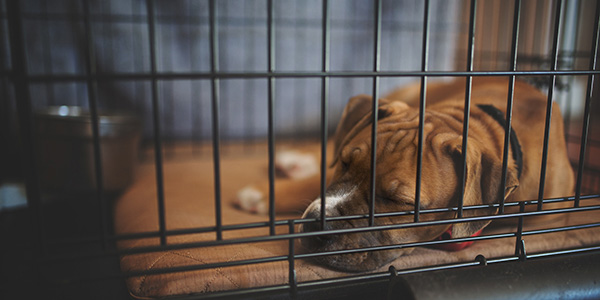
Activity reduction
Because this is an orthopedic surgery affecting your dog's leg and mobility, activity reduction will be prolonged as bones take longer to heal than soft tissues such as muscles and skin.
Typically, activity restriction with CCL surgery repair will last between 8–12 weeks (2–3 months) and will involve strict crate rest. So, ensure you have purchased a correctly sized crate prior to your dog’s arrival home. Read more on tips to measure for the right crate size.
Your dog will not be allowed to jump, play roughly, go on long walks, or go to the dog park. They also won’t be able to use any stairs or jump on or off furniture. Your dog will ideally rest inside a crate, particularly when not monitored. Dogs that use their injured leg too much too soon may cause the surgery to fail.
Note: Following this period of strict activity restriction, there will be a period (about a month) of gradual or controlled return to activity. Once the 3-month period is over, your dog can return to full activity. If this timing isn't followed, they are at risk of injuring themselves.
Incision care
Depending on the type of surgery your veterinarian performed to repair the torn CCL will depend on the location of the incision. Some veterinarians prefer to use internal skin sutures; however, this does NOT mean that your dog doesn’t need to wear their cone or their incision monitored just as closely. The only difference is that your dog doesn’t need stitches removed in 10–14 days, as they will dissolve.
Bandage care
Your dog may or may not need to wear a bandage for 1–2 days.
Medication
Typically, your dog will be prescribed non-steroidal anti-inflammatory pain medication and analgesic pain medication. Possibly sedatives and/or antibiotics.
Any form of orthopedic surgery is considered extremely painful. Essentially, all of them require ‘trauma’ to the periosteum, and this is where the mechanosensitive nerve fibers that detect and signal pain are located. For these reasons, it is essential that you administer your dog’s medications as directed.
How long should your dog wear a cone?
For up to 8+ weeks, depending on the type of procedure performed.
Is a cone alternative allowed? If appropriate for your dog, you can try a lick sleeve or alternative collar option.
Caring for Your Dog After Eye Surgery (Mass Removal, Enucleation, Cataracts)
Like orthopedic surgeries, eye (and facial surgeries) have their own special care needs. For the best outcome, following your veterinarian’s discharge instructions is essential.
Activity reduction
Typically, it is recommended a dog is strictly rested for 14 days. But for cataract surgery, restriction is typically up to 4 weeks. No jumping, rough play, long walks, up and down stairs, or jumping on and off furniture.
DO NOT let your pet play with any toys that they can shake since head shaking can injure the eye. Ideally, they should be rested inside a crate, particularly when not monitored.
Your veterinarian may recommend dim lighting in your pet’s recovery area to help optimize recovery.
Dogs should be walked using a harness as there is a risk of increased pressure in the eye if they pull on a neck collar. Additionally, there is risk of injury to the eye when putting a collar on and off.
Incision care
Monitor for signs of infection, pain, swelling, or discharge twice daily. If noted, contact your veterinarian ASAP.
Depending on the procedure, your veterinarian may have you apply a warm compress twice daily for 5 minutes or prescribe a special eye cleansing solution.
Bandage care
Typically, no bandage is needed.
Medication
Typically, your dog will be prescribed non-steroidal anti-inflammatory pain medication, analgesic pain medication. Possibly eye medications (dependent on type of procedure), sedatives, and/or antibiotics.
How long should your dog wear a cone?
Dogs should wear a cone for 14 days after eye surgery.
Is a cone alternative allowed? Not recommended for eye surgeries.
Caring for Your Dog After a Dental Cleaning
While a dental cleaning isn't considered a surgery in the normal sense of the term, your dog is put under anesthesia, and they will likely feel pain, especially if there were tooth extractions.
Activity reduction
Typically, for routine cleaning, dogs should have restricted activity for 24 to 48 hours or until they have fully recovered from anesthesia.
For dogs that have had dental extractions, activity restriction up to 72 hours may be needed. Following that, avoid rigorous play, jumping, or any activities that may cause injury to the surgical site.
Incision care
Monitor the extraction sites for signs of infection or complications (dehiscence). This includes redness, swelling, discharge, foul odor, or an opened incision. If you notice any of these signs, contact your veterinarian.
Feed your dog soft or wet food to prevent irritation to the surgical site and lessen discomfort when chewing. Your veterinarian may have you flush your dog’s mouth after eating.
Note: Avoid hard treats since they can irritate the surgical site. Do not give your dog edible chews or chew toys until the incisions are healed (about 10 to 14 days).
Bandage care
No bandage is needed.
Medication
For dental cleanings, no medications are needed, but your veterinarian will recommend a dental hygiene protocol.
Dental extractions are painful. Typically, your dog will be prescribed non-steroidal anti-inflammatory pain medication and analgesic pain medication. Antibiotics are not routinely prescribed.
How long should your dog wear a cone?
For a routine dental cleaning, a cone is not needed.
Following dental extractions, if your dog is pawing or rubbing their face, a cone is essential to prevent infection, surgical site dehiscence (opening) and allow healing. They will wear a cone for 10 to 14 days.
Is a cone alternative allowed? Not recommended for oral surgeries.
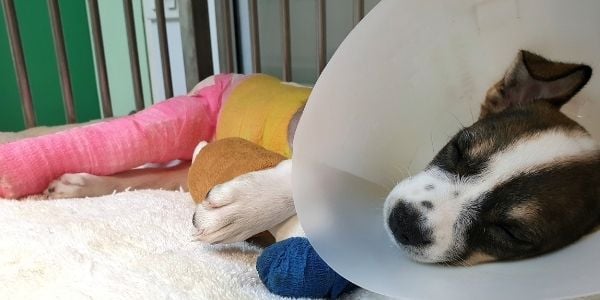
Having a post-operative patient to care for at home doesn’t have to be daunting. With the right planning and preparation, you can assist your pup through their recovery phase with ease.
Every surgery is going to result in a different outcome for each individual dog. However, hopefully, this guide will help get you through the most common procedures that most dogs experience in their lifetime.
The biggest takeaways are:
- Plan ahead
- Ensure you have everything you need before your dog arrives home
- Read and follow your veterinarian's instructions carefully
- Understand that not everything will go perfectly to plan
- It’s okay to call your vet if you’re concerned! It's actually really important that you do. It can save your dog a whole lot of additional discomfort and will likely help them heal faster. Plus, it can prevent a lot of unnecessary stress and anxiety.





